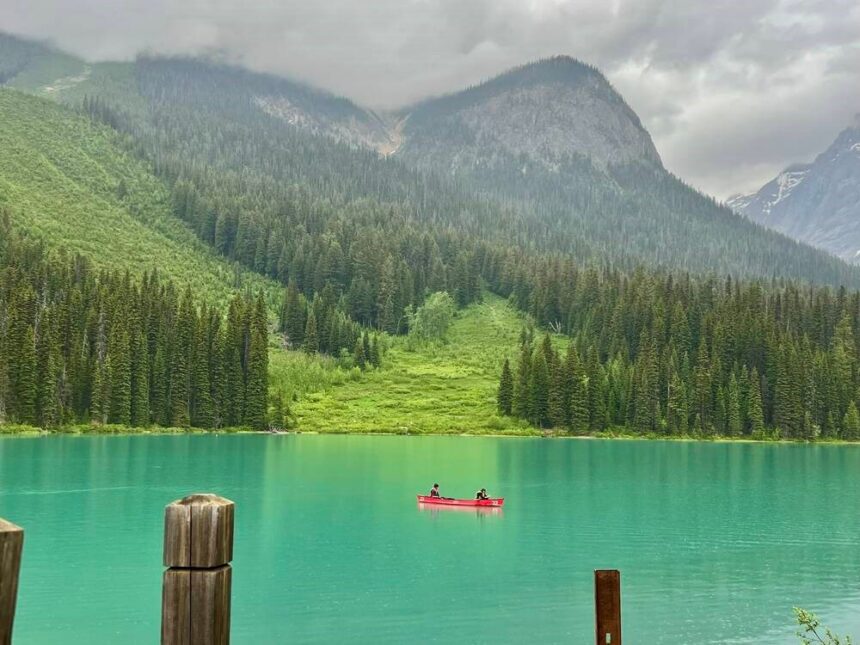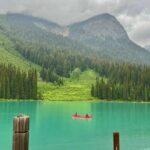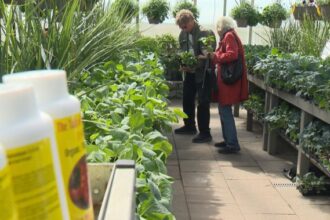The morning light spills over the Purcell Mountains, casting long shadows across the valley where Golden, British Columbia sits nestled between six stunning mountain ranges. There’s something distinctly European about this scene—a quality that has earned this small Canadian town its reputation as “Little Switzerland.” As I stand on the suspension bridge overlooking the rushing Kicking Horse River, it’s easy to understand why adventurers and mountain enthusiasts have been drawn to this alpine paradise for generations.
Golden isn’t simply mimicking Swiss charm—it embodies an authentic mountain culture born from its unique position as the birthplace of Canadian mountaineering. The town’s story begins in the late 19th century when the Canadian Pacific Railway hired Swiss guides to safely lead wealthy tourists through the treacherous mountain passes. These guides, with their unparalleled expertise in alpine navigation, not only established safety protocols but planted the seeds for what would become Canada’s mountaineering tradition.
“The Swiss guides fundamentally shaped how Canadians approach the mountains,” explains local historian Margaret Johnson, whom I meet at the Golden Museum. “They brought centuries of alpine knowledge and a philosophy that balanced respect for the mountains with a drive to explore them.”
This heritage is visible everywhere in Golden today. The Swiss Village, located at Edelweiss, features authentic alpine architecture with peaked roofs designed to shed heavy snow. Many buildings throughout town showcase the distinctive timber-framing techniques and decorative balconies reminiscent of chalets in Grindelwald or Zermatt. Yet Golden’s interpretation of this aesthetic isn’t merely decorative—it’s functional architecture born from similar environmental challenges faced in both the Canadian Rockies and the Swiss Alps.
Accommodations in Golden further enhance this mountain experience. The Kicking Horse Mountain Resort offers slope-side chalets that could have been transported directly from the Bernese Oberland. For a more authentic immersion, several family-run lodges showcase the region’s timber-building traditions while providing access to spectacular hiking trails.
Culinary offerings in Golden similarly reflect this Swiss-Canadian fusion. At the Mountain Word Café, chef Anton Braun creates rösti that rivals anything found in Bern, while incorporating locally foraged ingredients like wild mushrooms and berries. “We’re not trying to be Swiss,” Braun tells me as he serves a plate of golden potato pancakes topped with smoked Rocky Mountain trout. “We’re honoring the alpine traditions that shaped this town while celebrating what makes the Canadian Rockies unique.”
Beyond architecture and cuisine, Golden’s mountain culture centers around outdoor adventure. Yoho National Park and Glacier National Park provide endless opportunities for hiking, climbing, and wildlife viewing. The Kicking Horse Mountain Resort offers some of North America’s most challenging skiing, with terrain that would make even seasoned Swiss alpinists nod in appreciation. During summer, the same slopes transform into world-class mountain biking trails.
For those seeking a more contemplative mountain experience, the Kicking Horse Pedestrian Bridge—Canada’s longest free-standing timber frame bridge—offers panoramic views of the surrounding landscape. The nearby Rotary Trails provide accessible paths along the Columbia River wetlands, where visitors can spot eagles, osprey, and occasionally moose or bear.
What distinguishes Golden from other mountain destinations is how the community has preserved its working-class roots while embracing tourism. Unlike some overdeveloped resort towns, Golden maintains an authentic quality where logging trucks share roads with mountain bikes, and where fourth-generation residents mingle with seasonal workers and visitors.
“Golden has resisted becoming a theme park version of an alpine village,” notes tourism director Catherine Parker. “The Swiss influence is genuine because it’s part of our historical DNA, not something we manufactured to attract tourists.”
This authenticity extends to the cultural events that punctuate Golden’s calendar. The annual Mountain Festival celebrates the town’s heritage with competitive events that would feel familiar to anyone who has attended a Swiss alpine festival—log-sawing competitions, mountain races, and traditional music that echoes through the valley.
As daylight fades and the mountains turn purple against the darkening sky, I join locals at the Wolf’s Den pub, where conversations flow between tales of backcountry adventures and community projects. Here, the Swiss-Canadian heritage feels less like a tourism strategy and more like a lived reality—a culture shaped by mountains and those bold enough to explore them.
Golden offers what many seek but few mountain destinations deliver: an authentic alpine experience that honors its European influences while remaining distinctly Canadian. In a world of increasingly manufactured travel experiences, this small town provides something genuine—a place where the Swiss alpine tradition hasn’t been imported but integrated into the very fabric of mountain life.
For those looking to escape into mountain grandeur without crossing the Atlantic, Golden represents not just a substitute for the Swiss experience, but a unique interpretation of alpine culture that has evolved in the heart of the Canadian Rockies. As I prepare to leave, I wonder: in our quest for authentic travel experiences, haven’t we been searching for places exactly like this—destinations that don’t simply mimic others but tell their own compelling stories against a backdrop of natural splendor?
The answer, like Golden itself, feels both foreign and familiar—a Swiss-inspired haven that’s unmistakably, proudly Canadian.
For more travel insights and cultural perspectives, visit our CO24 Opinions section.










